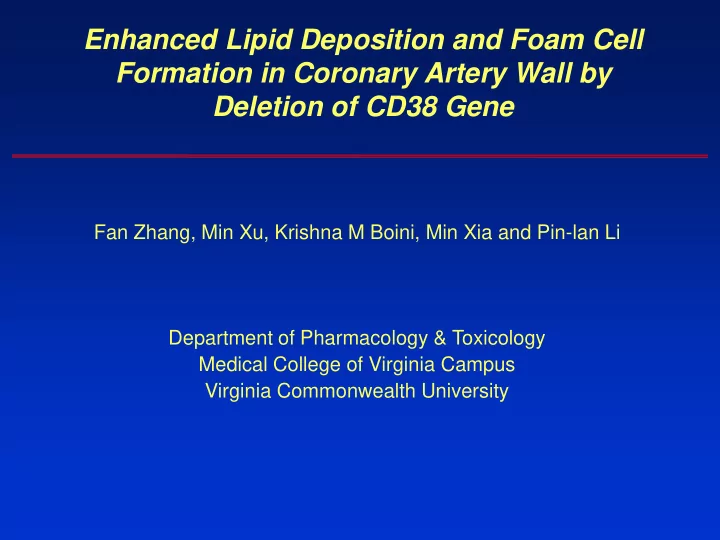

Enhanced Lipid Deposition and Foam Cell Formation in Coronary Artery Wall by Deletion of CD38 Gene Fan Zhang, Min Xu, Krishna M Boini, Min Xia and Pin-lan Li Department of Pharmacology & Toxicology Medical College of Virginia Campus Virginia Commonwealth University
NAADP and Lysosomal TRP-ML1 NAADP (Nicotinic Acid Adenine Dinucleotide Phosphate) Ca 2+ is an newly - discovered intracellular second messenger that participates in a variety of pathophysiological processes. This nucleotide has been found to release Ca 2+ from Lysosomal TRP-ML1 (Transient Receptor Potential- Mucolipin 1) channel. NAADP is mainly produced through an enzyme, CD38 ADP - ribosylcyclase, by catalyzing the exchange of nicotinamide in NADP as a substrate with nicotinic acid.
Lysosomal TRP-ML1 and Lipids Deposition TRP-ML1 is a specific lysosome membrane - located non-specific Ca 2+ release channel. Clinically, TRP-ML1 mutation has been confirmed as a critical genetic determinant for the lysosomal lipids storage diseases, such as Mucolipidosis type IV.
Lysosomal Cholesterol Accumulation in Atherosclerosis Advanced atherosclerotic foam cell formation has features of an acquired lysosomal storage disorder. The accumulated lipids in lysosomes are rich in cholesteryl ester and free cholesterol, and the retarded free cholesterol efflux has been found to play a critical pathogenic role in lysosome lipids deposition.
Hypothesis Abnormal CD38-TRP-ML1 regulation of lysosome function importantly contributes to lipid deposition and foam cell formation in coronary artery wall.
Histological Evidence of Atherosclerosis in CD38 -/- Mouse Coronary Artery B A Normal Diet Western Diet Normal Diet Western Diet CD38 +/+ CD38 +/+ CD38 -/- CD38 -/- 40 x
Electron Microscope Evidence of Atherosclerosis +/+ in CD38 -/- Mouse Coronary Artery A B C Western Diet Western Diet Normal Diet CD38 +/+ CD38 -/- CD38 +/+ X 12,000
NAADP Conversion Rate Was Decreased in CD38 -/- Macrophage by HPLC Assay CD38 NAADP NADP+ Nicotinic Acid 0.16 Conversion Rate of NADP (nmol/min/mg protein) 0.12 * 0.08 0.04 0.00 CD38 -/- CD38 -/- +Rescue CD38 +/+
Enhanced Lipids Deposition in CD38 -/- Macrophages A B CD38 +/+ CD38 -/- Relative Oil Red Extract Absorption 6 * 2+ Basal 5 ox-LDL Basal 4 3 2 oxLDL 1 0 CD38 +/+ CD38 -/-
NAADP Signaling Antagonists Increased Lipids Deposition in CD38 +/+ Macrophages A B Basal Relative Oil Red Extract Absorption * 7 6 * 5 * oxLDL Nicot+oxLDL 4 # 3 2 1 PPADS+oxLDL Baf+oxLDL 0 Ox-LDL
Further Confirm NAADP Signaling Antagonists Increased Lipids Deposition in CD38 +/+ Macrophages B A Relative Fluorescence Intensity 4 * * * 3 * 2 1 0 Ctrl Nicot PPADS Baf TRP-ML1 shRNA
CD38 Gene Transfection Attenuated Foam Cells Formation in CD38 -/- Macrophages A B CD68/Alexa Overlay Fluor 594 CD38-GFP 3.0 Fluorescence Intensity Ratio CD38 -/- * CD68-Fluor 594/GFP 2.5 2.0 GFP 1.5 CD38 -/- 1.0 0.5 GFP 0.0 CD38 +/+ CD38 +/+ CD38 -/- CD38 -/- + CD38-GFP GFP
NAADP Signaling Antagonists Increased Foam Cell Formation in CD38 +/+ Macrophages B A Vehicle ox-LDL 16 Relative CD68-Fluor 594 Intensity * 14 * * * 12 10 PPADS+ Baf+ ox-LDL ox-LDL 8 6 4 TRP-ML1shRNA+ Nicot+ 2 ox-LDL ox-LDL 0 oxLDL
NAADP Increased Cholesterol Efflux from Lysosomes in CD38 -/- Macrophages B A Lamp-1/ Cholesterol Overlay /Filipin Alexa Fluor 555 Basal 0.7 * # Normalized Cholesterol/Filipin 0.6 oxLDL Fluorescence Intensity 0.5 0.4 0.3 oxLDL +CD38 rescue 0.2 0.1 NAADP(100nM) oxLDL 0.0 oxLDL+ TRP-ML1shRNA NAADP(100nM)
Conclusion CD38-NAADP-TRP-ML1 signaling pathway play a critical role in the regulation of lysosomal lipids deposition in macrophages and foam cell formation.
Clinical Relevance CD38-NAADP/TRP-ML1 pathway may act as an important signaling in the pathogenesis of atherosclerosis. This signaling pathway could be an important therapeutic target for the prevention and treatment of atherosclerosis.
Thank you!
Recommend
More recommend